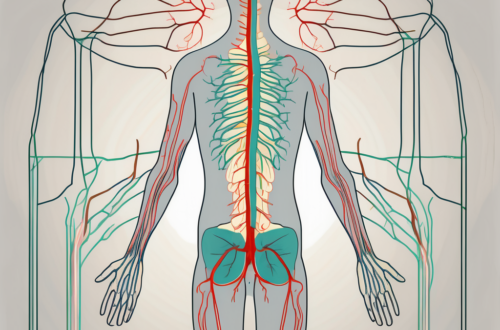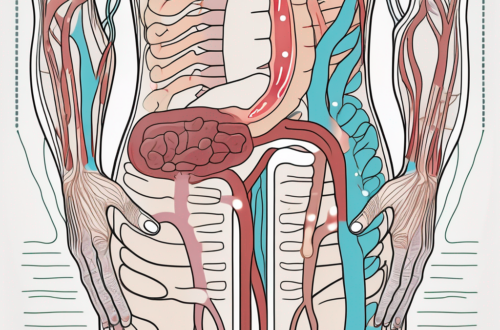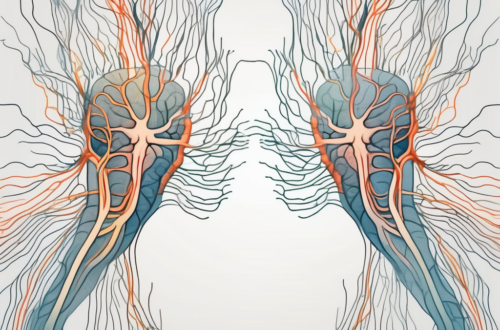The functioning of the parasympathetic nervous system is crucial for maintaining the overall well-being of our bodies. It plays a significant role in regulating numerous bodily functions, including digestion, rest, and relaxation. In this comprehensive guide, we will delve into the intricacies of the parasympathetic nervous system, its anatomy, functions, and its importance in maintaining health.
An Overview of the Nervous System
Before diving into the specifics of the parasympathetic nervous system, it is essential to have a basic understanding of the overall nervous system. The nervous system is a complex network of cells that transmit signals between different parts of the body. It plays a crucial role in coordinating and controlling bodily functions, allowing us to perceive and respond to the world around us.
The nervous system is divided into two main components: the central nervous system (CNS) and the peripheral nervous system (PNS). The CNS comprises the brain and spinal cord and serves as the command center for the entire nervous system. It receives and processes information from the sensory organs, allowing us to make sense of our surroundings and initiate appropriate responses.
On the other hand, the PNS consists of nerves that extend throughout the body, connecting the CNS to various organs, muscles, and tissues. It acts as a communication network, transmitting signals between the CNS and the rest of the body. The PNS can be further divided into the somatic nervous system and the autonomic nervous system.
The Central and Peripheral Nervous Systems
The central nervous system, consisting of the brain and spinal cord, is like the control center of the body. It receives and processes information from the sensory organs, allowing us to perceive the world around us and make sense of it. The brain, with its billions of neurons, is responsible for higher cognitive functions such as thinking, memory, and decision-making. The spinal cord, on the other hand, acts as a relay station, transmitting signals between the brain and the rest of the body.
The peripheral nervous system, on the other hand, is like a vast network of communication lines that connect the central nervous system to the rest of the body. It consists of nerves that extend throughout the body, branching out into smaller nerves that reach every organ, muscle, and tissue. These nerves transmit signals from the central nervous system to the muscles, allowing us to move, and to the organs, allowing us to regulate bodily functions.
The peripheral nervous system can be further divided into the somatic nervous system and the autonomic nervous system. The somatic nervous system controls voluntary movements, allowing us to consciously move our muscles and interact with the environment. It is responsible for actions such as walking, talking, and writing.
The Autonomic Nervous System: Sympathetic and Parasympathetic
Within the peripheral nervous system, there is a branch known as the autonomic nervous system (ANS), which controls involuntary bodily functions. The ANS regulates processes such as heart rate, digestion, and breathing, which occur automatically without conscious effort.
The autonomic nervous system is further divided into two main divisions: the sympathetic and parasympathetic nervous systems. These two divisions work together to maintain a delicate balance in the body’s physiological processes, ensuring that they function optimally in different situations.
The sympathetic nervous system is responsible for the “fight or flight” response, which prepares the body for action in response to perceived threats. When faced with a dangerous situation, such as encountering a predator, the sympathetic nervous system kicks into gear, releasing stress hormones, increasing heart rate, dilating blood vessels, and redirecting blood flow to the muscles, preparing the body to either fight the threat or flee from it.
On the other hand, the parasympathetic nervous system acts as the counterpart to the sympathetic nervous system. It promotes relaxation and conserves energy when the body is at rest. When we are in a state of rest and digest, the parasympathetic nervous system slows down heart rate, constricts blood vessels, and increases digestive activity, allowing the body to rest, repair, and recover.
The sympathetic and parasympathetic nervous systems work in harmony, constantly adjusting and adapting to the body’s needs. They ensure that our bodily functions are regulated appropriately, allowing us to respond effectively to different situations and maintain overall well-being.
The Parasympathetic Nervous System: An In-depth Look
Now, let’s focus on the parasympathetic nervous system, exploring its anatomy and understanding its vital functions.
Anatomy of the Parasympathetic Nervous System
The parasympathetic nervous system primarily originates from two main regions: the cranial nerves and the sacral region of the spinal cord. The cranial nerves, such as the vagus nerve, play a crucial role in innervating various organs, including the heart, lungs, and digestive system. The sacral region, on the other hand, controls the parasympathetic innervation of the pelvis and lower abdominal organs.
The vagus nerve, also known as the wandering nerve, is the longest cranial nerve in the body. It extends from the brainstem to the abdomen, innervating multiple organs along the way. This nerve is responsible for regulating heart rate, controlling the muscles involved in swallowing and speech, and stimulating digestive processes. It also plays a role in reducing inflammation and promoting relaxation.
In the sacral region of the spinal cord, the parasympathetic fibers originate from the second, third, and fourth sacral segments. These fibers travel through the pelvic nerves and innervate the bladder, reproductive organs, and lower abdominal organs. They are responsible for controlling the bladder’s ability to contract efficiently, promoting sexual arousal, and regulating bowel movements.
Functions of the Parasympathetic Nervous System
The parasympathetic nervous system is involved in numerous essential bodily functions. It regulates heart rate, ensuring that it remains within a healthy range. When the body is at rest, the parasympathetic system dominates, slowing down the heart rate and promoting relaxation.
Respiratory rate is also regulated by the parasympathetic nervous system. During periods of rest, the system works to decrease the respiratory rate, allowing the body to conserve energy. It also promotes deeper and more efficient breathing, ensuring that the body receives an adequate supply of oxygen.
In addition to its role in cardiovascular and respiratory functions, the parasympathetic nervous system plays a vital role in digestion. It ensures the smooth functioning of the gastrointestinal tract, promoting the movement of food through the digestive system. It stimulates secretions that aid in digestion, such as gastric acid and digestive enzymes. This system also promotes the release of saliva, tears, and other lubricating fluids, which are essential for proper oral and ocular health.
Furthermore, the parasympathetic nervous system is responsible for the constriction of the pupil and the accommodation of the lens in the eye, thus enabling us to see objects at different distances clearly. This process, known as pupillary constriction and accommodation, is essential for visual clarity and adaptation to varying light conditions.
Sexual arousal is also influenced by the parasympathetic nervous system. It plays a role in the physiological responses associated with sexual activity, such as genital engorgement and lubrication. The system works in conjunction with the sympathetic nervous system to facilitate sexual function and reproduction.
Lastly, the parasympathetic nervous system is involved in the control of the bladder’s ability to contract efficiently. It coordinates the relaxation of the bladder’s smooth muscles and the contraction of the bladder’s detrusor muscle, allowing for effective urination. Dysfunction of the parasympathetic system can lead to urinary retention or incontinence.
The Role of Parasympathetic Nerve Functioning in Health and Disease
The proper functioning of the parasympathetic nervous system is crucial for maintaining homeostasis, a balanced state within the body. Let’s explore the impact of parasympathetic nerve functioning on our overall health.
Parasympathetic Nerve Functioning in Maintaining Homeostasis
The parasympathetic nervous system works hand in hand with the sympathetic nervous system to maintain homeostasis. It counters the effects of the sympathetic system, ensuring that the body returns to a resting state after experiencing stress or excitement. By promoting relaxation and conserving energy, the parasympathetic system helps maintain a balanced state within our body systems.
When the body is in a state of rest, the parasympathetic nervous system takes charge. It slows down the heart rate, decreases blood pressure, and stimulates digestion. This allows our body to conserve energy and focus on essential functions such as digestion, elimination, and repair.
Furthermore, the parasympathetic system plays a vital role in promoting restful sleep. It helps to calm the mind and body, preparing us for a rejuvenating sleep cycle. During sleep, the parasympathetic system continues to regulate bodily functions, ensuring that our body remains in a state of balance and repair.
Parasympathetic Nerve Dysfunction and Disease
When the parasympathetic nervous system fails to function correctly, it can lead to various health issues. Autonomic disorders, such as dysautonomia, can disrupt the normal functioning of the parasympathetic system, leading to symptoms such as dizziness, fainting, and digestive problems.
Dysautonomia is a complex condition that affects the autonomic nervous system, including both the sympathetic and parasympathetic branches. It can result from various causes, including genetic factors, autoimmune disorders, and nerve damage. The dysfunction of the parasympathetic system in dysautonomia can lead to an imbalance in bodily functions, affecting multiple systems such as cardiovascular, gastrointestinal, and respiratory.
Seeking medical attention and consulting with a healthcare professional is essential for a proper diagnosis and management of such conditions. Treatment options for parasympathetic nerve dysfunction may include lifestyle modifications, medications, and therapies aimed at restoring the balance of the autonomic nervous system.
In conclusion, the parasympathetic nervous system plays a crucial role in maintaining homeostasis and overall health. Its proper functioning ensures that our body remains in a balanced state, allowing for optimal bodily functions and well-being. However, when the parasympathetic system malfunctions, it can lead to various health issues, emphasizing the importance of seeking medical attention and proper management.
Assessing Parasympathetic Nerve Function
Medical professionals employ various methods to evaluate parasympathetic nerve function. Let’s take a closer look at these assessment techniques.
Assessing parasympathetic nerve function is crucial in understanding the overall health and functioning of the autonomic nervous system. The parasympathetic nervous system plays a vital role in regulating various bodily functions, including heart rate, blood pressure, digestion, and pupil constriction.
Clinical Evaluation of Parasympathetic Nerve Function
A qualified healthcare provider may evaluate parasympathetic nerve function by assessing the patient’s heart rate variability, blood pressure response, and pupillary reflexes. These tests can provide valuable insights into the overall functioning of the parasympathetic system.
Heart rate variability (HRV) is a measure of the variation in time intervals between consecutive heartbeats. It reflects the adaptability and flexibility of the autonomic nervous system. By analyzing HRV, healthcare providers can assess the balance between sympathetic and parasympathetic activities. A higher HRV indicates a healthier parasympathetic function.
Blood pressure response is another important parameter in evaluating parasympathetic nerve function. The parasympathetic system helps regulate blood pressure by promoting vasodilation and reducing heart rate. A blunted blood pressure response may indicate impaired parasympathetic activity.
Pupillary reflexes, such as constriction in response to light, are controlled by the parasympathetic nervous system. Evaluating pupillary reflexes can provide insights into the integrity of the parasympathetic pathways. Abnormalities in pupillary reflexes may indicate dysfunction in the parasympathetic system.
Laboratory Tests for Parasympathetic Nerve Function
While clinical evaluations provide a good initial assessment, laboratory tests can offer more detailed information about parasympathetic nerve function. These tests often involve specialized equipment and expert interpretation.
One commonly used laboratory test is the autonomic function test (AFT). This test involves measuring various physiological parameters, such as heart rate, blood pressure, and sweating response, while subjecting the patient to specific stimuli. The results of the AFT can help identify specific areas of parasympathetic dysfunction.
Another laboratory test is the heart rate response to deep breathing. This test measures the heart rate changes in response to controlled deep breathing. A healthy parasympathetic function is associated with a significant decrease in heart rate during deep inhalation and an increase during exhalation.
In addition to these tests, specialized imaging techniques, such as functional magnetic resonance imaging (fMRI) and positron emission tomography (PET), can provide insights into the brain’s involvement in parasympathetic regulation. These imaging modalities can help identify any structural or functional abnormalities in the central nervous system that may affect parasympathetic nerve function.
Overall, assessing parasympathetic nerve function involves a combination of clinical evaluations and laboratory tests. These techniques provide valuable information about the integrity and functioning of the parasympathetic system, allowing healthcare providers to diagnose and treat any underlying conditions that may be affecting autonomic regulation.
Therapeutic Approaches to Enhance Parasympathetic Nerve Function
There are several approaches to support and enhance parasympathetic nerve function. It is important to note that the following suggestions should be discussed with a healthcare professional before implementation.
Lifestyle Modifications for Parasympathetic Health
Leading a healthy lifestyle can positively impact parasympathetic nerve functioning. Engaging in stress-reducing activities such as yoga, meditation, and deep breathing exercises can promote relaxation and activate the parasympathetic system.
Yoga, a practice that combines physical postures, breathing exercises, and meditation, has been shown to have a calming effect on the nervous system. It helps reduce stress and anxiety, allowing the parasympathetic nervous system to function optimally. By focusing on slow, deliberate movements and controlled breathing, yoga promotes a state of deep relaxation that activates the rest-and-digest response.
Meditation, another effective technique for enhancing parasympathetic nerve function, involves focusing the mind and eliminating the stream of thoughts that often contribute to stress. By practicing mindfulness and redirecting attention to the present moment, meditation helps reduce sympathetic nervous system activity and promotes a state of calmness and relaxation.
In addition to yoga and meditation, deep breathing exercises can also activate the parasympathetic system. By taking slow, deep breaths and focusing on the inhalation and exhalation, individuals can stimulate the vagus nerve, a key component of the parasympathetic nervous system. This activation helps slow down the heart rate, lower blood pressure, and induce a state of relaxation.
Adequate sleep is another crucial factor in maintaining parasympathetic health. During sleep, the body repairs and rejuvenates itself, allowing the parasympathetic system to function optimally. By prioritizing sleep and ensuring a consistent sleep schedule, individuals can support their parasympathetic nerve function.
A balanced diet is also essential for parasympathetic health. Consuming a variety of nutrient-rich foods, including fruits, vegetables, whole grains, and lean proteins, provides the body with the necessary vitamins and minerals to support optimal nerve function. Additionally, avoiding excessive consumption of stimulants such as caffeine and nicotine can help prevent overstimulation of the sympathetic nervous system and promote parasympathetic balance.
Regular exercise is another lifestyle modification that positively impacts parasympathetic nerve function. Engaging in physical activity, such as walking, jogging, or swimming, promotes the release of endorphins, which are natural mood enhancers. Exercise also helps reduce stress, improve sleep quality, and enhance overall well-being, all of which contribute to a healthy parasympathetic system.
Medications and Therapies for Parasympathetic Nerve Function
Medical interventions may be necessary to enhance parasympathetic nerve function in certain cases. Medications such as cholinergic agonists or therapies like biofeedback and acupuncture may be prescribed by healthcare professionals.
Cholinergic agonists are medications that mimic the effects of acetylcholine, a neurotransmitter involved in parasympathetic nerve function. These medications can help stimulate the parasympathetic system and promote relaxation. However, it is important to consult with a healthcare provider to determine the appropriate dosage and potential side effects.
Biofeedback is a therapeutic technique that allows individuals to gain control over certain bodily functions, including heart rate, blood pressure, and muscle tension. By providing real-time feedback on these physiological processes, biofeedback helps individuals learn how to regulate their parasympathetic response and promote relaxation.
Acupuncture, an ancient Chinese practice, involves the insertion of thin needles into specific points on the body. This technique is believed to stimulate the flow of energy, or Qi, and restore balance in the body. Acupuncture has been shown to have a calming effect on the nervous system, promoting parasympathetic activation and reducing stress.
It is crucial to consult with a healthcare provider to determine the most appropriate approach for individual circumstances and medical history. They can assess the underlying causes of parasympathetic dysfunction and recommend the most effective therapeutic interventions to enhance parasympathetic nerve function.
Future Directions in Parasympathetic Nerve Research
Research into the parasympathetic nervous system is ongoing and holds promising potential for understanding its intricate workings. Let’s explore emerging areas of research and their potential implications.
Emerging Research on Parasympathetic Nerve Function
Scientists are diligently studying the parasympathetic nervous system to unveil its complex mechanisms further. A better understanding of how the parasympathetic system functions can potentially lead to advancements in treating autonomic disorders and related conditions.
Potential Implications for Treatment and Prevention Strategies
As research progresses, the potential implications for treatment and prevention strategies are becoming clearer. Discoveries in this field may pave the way for innovative interventions that aim to improve parasympathetic nerve functioning, ultimately promoting overall well-being and health.
In conclusion, the parasympathetic nervous system plays a crucial role in maintaining the balance and harmony of our bodily functions. Understanding its anatomy, functions, and importance in overall health is essential in appreciating the complexity of the human body. By consulting with healthcare professionals and implementing appropriate strategies, we can support and enhance parasympathetic nerve function, contributing to our overall well-being and quality of life.





